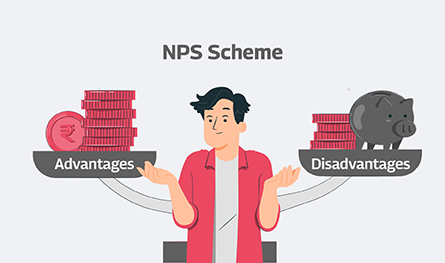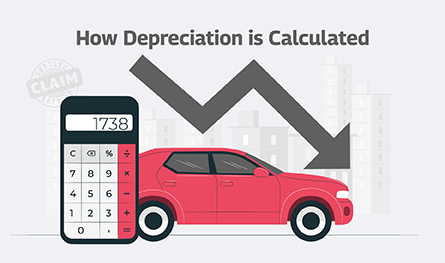Advantages and Disadvantages of National Pension Scheme (NPS) Scheme

The National Pension Scheme (NPS) is a plan introduced by the Government of India. The scheme offers high interest rate and good return on investment to safeguard the interest of the policyholders.

- Overview of the National Pension Scheme (NPS) Scheme
- Pros of NPS Scheme: Top 9 Advantages and Benefits of NPS
- Cons of NPS Scheme: 6 Disadvantages and Drawbacks of NPS
- National Pension Scheme Central Recordkeeping Agency (CRA) Login
- Is it worth investing in National Pension Scheme (NPS) Scheme?
- Top 11 NPS Fund Managers in India 2024
NPS is a pension saving scheme with defined contributions and is designed to offer systematic savings over a long period of time. National Pension System scheme is governed by Pension Fund Regulatory and Development Authority (PFRDA) of India.
The scheme inspires working individuals to invest regularly in a pension account, to allow them to withdraw a certain amount of accumulated sum once they are retired. The remaining sum is offered as a monthly pension to the retiree.
In this post, we will discuss the pros and cons and other NPS scheme details to help you understand the plan better.
Overview of the National Pension Scheme (NPS) Scheme
NPS is a market-linked product of defined contribution. Under this scheme, the subscribers are allotted a unique PRAN or Permanent Retirement Account Number. This number is created and maintained by the CRA or Central Recordkeeping Agency for subscribers. Tier-I and Tier-II are two types of NPS accounts.
Under NPS, employees are encouraged to invest at regular intervals. Once the NPS lock-in period is over, the investor can withdraw an amount of money from the corpus saved, while the rest of the amount can be availed by the account holder as a monthly pension after retirement.
Pros of NPS Scheme: Top 9 Advantages and Benefits of NPS
Here are some pros of National Pension System accounts as mentioned below for you to see if the account suits your appetite.
- Good NPS Fund Managers – The best thing about NPS is that the funds under the scheme are invested by able and qualified fund managers. These fund managers are controlled by Pension Fund Regulatory and Development Authority (PFRDA).
- Good Returns – The NPS Tier 2 account allows good and high returns, which accumulates in its long tenure to allow the investor a substantial amount of investment at retirement. NPS Tier 1 funds are also used as pension amounts. A major chunk of NPS investment is invested in the equity market that allows much higher returns as compared to EPF.
- Low Investment Cost – NPS Tier 1 account needs just INR 500 as a minimum investment amount to open the account. On the other hand, the Tier 2 account requires INR 1000 as the minimum investment amount to open the account. The account holder can deposit the amount via cash, cheque etc.
- Easy Paperwork – The NPS do not require any complicated process to enter the scheme. An interested individual can enter the scheme easily through several avenues such as online option of NPS CRA Login page or via the manual process of collecting NPS form and submitting papers like address and identity proof.
- Greater Coverage – NPS scheme allows the participation of all Indian citizens as well as NRIs to invest in the scheme. The age group of eligible candidates include 18 to 60 years since it is a pension plan.
- Better Regulations to Ensure Investment Safety – NPS schemes offer secured investment options through good regulations. Thus, it allows the subscriber to enjoy better and safe returns.
- Easy Access – The interested individual can visit any nearby branch of a public or private sector bank to apply in the NPS account. Also, it can be done online via the NPS CRA login.
- Portability – NPS is a portable scheme that continues to stay active even if the policyholder changes their job, city etc. The PRAN number and the NPS CRA login credentials stay active.
- Tax benefits – NPS account allows tax exemption under section 80CCD (1B) and under section 80C for salaried individuals. Also, up to 10% of basic salary along with dearness allowance can be claimed by a salaried individual among others.
Even self-employed account holders can claim tax exemption similar to that of salaried people under section 80CCD (1B) and under section 80C. They can also invest over 20% of their gross annual income to claim tax exemption under section 80CCD (1).
Cons of NPS Scheme: 6 Disadvantages and Drawbacks of NPS
There are some disadvantages of National Pension System scheme as mentioned below:
- Limits on amount withdrawal – NPS comes with a lock-in period. Further, there are restrictions on the withdrawal from the pension amount. In fact, NPS restricts any kind of withdrawals until the policyholder reaches 60 years of age. The NPS account holder can make the first withdrawal from the account after 10 active years of the account. They are allowed a maximum of 3 withdrawals until they reach 60 years of age. Also, the withdrawal amount of the account cannot be more than the entire sum contributed by the subscriber.
- Taxation at maturity – The corpus received at maturity that is used by the NPS account holder for buying an annuity is taxable under this plan. The government of India levies tax on 60% of NPS investment, while the remaining 40% escapes the taxation amount.
- Restrictions while opening account – Only one NPS account can be opened by a single individual using the credentials of NPS CRA login.
- Annuity is Mandatory – NPS account restricts the withdrawal of account holders from Tier 1, which is the main account for savings for pension. Further, during maturity the NPS account allows the withdrawal of 60% of the funds, while the rest of the 40% is used to buy the annuity.
- Lock-in Period of NPS – Being a pension plan, the lock-in period under NPS is till your retirement age, which is 60 years.
- Complexity of opting for the Best Fund Manager for NPS – There are many people who are unaware of the terms related to securities, equities, debt etc. And thus, these people fail to choose the best NPS fund manager for their NPS investments.
National Pension Scheme Central Recordkeeping Agency (CRA) Login
The Pension Fund Regulatory and Development Authority (PFRDA) is the controlling body for the complete administration and guidelines of pensions in India. The authority has chosen Protean eGov Technologies Ltd. (formerly NSDL e-Governance Infrastructure) as the CRA or the Central Recordkeeping Agency for NPS-Lite.
Subscribers are required to generate an IPIN using PRAN to log in to the NSDL portal. They can use the NPS CRA login to generate this IPIN. Here are the steps to generate IPIN:
- Visit the official portal of NSDL CRA
- Submit the required details
- Create a new password and click the submit button
Your IPIN will be generated. Log in to the NSDL portal using this IPIN
- Go to the NSDL eNPS page and click on the “Log in with PRAN/IPIN” button
- You will be redirected to the NPS CRA login page. Here use your PRAN and IPIN to enter the NPS account.
Is it worth investing in National Pension Scheme (NPS) Scheme?
Several reasons make the NPS or National Pension Scheme worth investing including tax benefits, flexible contributions, low cost, flexible annuity, and security. For people looking at ideal investment options to save enough for retirement as well as to secure their financial future, NPS is the best option.
Here are some benefits of the scheme:
- NPS funds are managed by the best fund managers – The amount deposited in an NPS by the subscribers is managed by experienced professionals or fund managers regulated by PFRDA.
- Higher Returns – The investments made in the NPS accounts get higher returns accrued over time to give you a substantial amount by the time you retire. As compared to EPF, returns on NPS are much higher.
- Low Investments – NPS accounts including both Tier 1 and Tier 2 can be opened with a minor investment amount which can be deposited through cheque, cash, or demand draft.
- Easy Documentation – There are multiple avenues for a subscriber to enter the scheme such as via the NPS CRA Login page or through a manual process. The account can be opened by filling out the NPS form and submitting the ID and address proof.
- Safety regulations to protect investments – The NPS scheme investments are secured through regulations. So, they are safe and allow better returns.
- Easy Access – The scheme can be easily availed from any public or private sector banks as well as through online mode via NPS CRA login.
- Portability – The NPS CRA login or PRAN stays the same even if you change your employment, city, or state.
- Option to Change the Fund Manager – The NPS subscribers are given the option to change the pension fund manager if required
Top 11 NPS Fund Managers in India 2024
It is important to choose a good NPS fund manager for investment in your NPS account. Below are the NPS fund managers which can be considered for best NPS funds:
- Axis Asset Management
- SBI Pension Fund
- HDFC Pension Management
- Aditya Birla Sun Life Pension Management
- LIC Pension Fund
- ICICI Prudential Pension Fund Management
- DSP Investment Managers
- Max Life Pensions
- Kotak Mahindra Pension Fund
- Tata Pension Funds
- UTI Retirement Solutions
FAQs: Advantages and Disadvantages of the National Pension Scheme (NPS) Scheme
Yes, NPS does make for a good retirement savings scheme and worth investing. Though, it may not be the best scheme to invest in if you aim to save for some specific purposes like children's education, marriage etc. However, for other needs, a PPF serves as the best scheme of investment.
Yes, you can invest in both NPS and PPF.
Any Indian citizen in the age group of 18-60 years can open an NPS account.
Normal exit is allowed after completion of 3 years of NPS scheme.
If you do not wish to continue your NPS account or defer your withdrawal, you can exit from NPS anytime.

Author Bio
Paybima Team
Paybima is an Indian insurance aggregator on a mission to make insurance simple for people. Paybima is the Digital arm of the already established and trusted Mahindra Insurance Brokers Ltd., a reputed name in the insurance broking industry with 17 years of experience. Paybima promises you the easy-to-access online platform to buy insurance policies, and also extend their unrelented assistance with all your policy related queries and services.
Other Life Insurance Products
Latest Post
So, you’ve crossed the fabulous 60 mark. Retirement may be on the cards, your kids might be off doing their own thing, and suddenly your knees are making more noise than your WhatsApp notifications. Welcome to the senior citizen club.
Now let’s talk about something most of us tend to postpone until a doctor gives us a reality check: health insurance. If you are wondering whether buying health insurance after 60 makes sense, the answer is a loud and clear yes. This article will cover everything you need to know about it, how it makes sense, how it differs from health insurance for young adults, and what you need to look out for when checking for medical insurance above the age of 60.

.png)
April 2 is observed as World Autism Awareness Day and there is no better way to observe the day than to raise awareness of this condition and to promote kindness towards autistic people. Read on to know more.


Car depreciation implies the difference between the cost of a car at the time of buying the car and when you sell it. A car insurance claim amount is determined by the car depreciation rate. The car depreciation rate is the reduction in the value of your car over its lifespan caused by wear and tear.


Fixed Deposits (FDs) are one of the safest ways to grow your savings. HDFC Bank offers attractive FD interest rates, allowing you to earn guaranteed returns on your investment. But before you invest, it's important to know how much interest you will earn and what your final maturity amount will be.


If you think of life insurance, chances are you are picturing something people buy in their 30s or 40s. But what if you are 65 or older and just getting started? The good news is that you are never too late. Whether you are thinking of easing the financial burden on your family, covering final expenses, or simply leaving behind a legacy, there are life insurance options tailored just for you.
This article will be a guide to life insurance for senior citizens above 65 years, explaining why it is important, the type of insurance options, and how to get the right policy for you.




